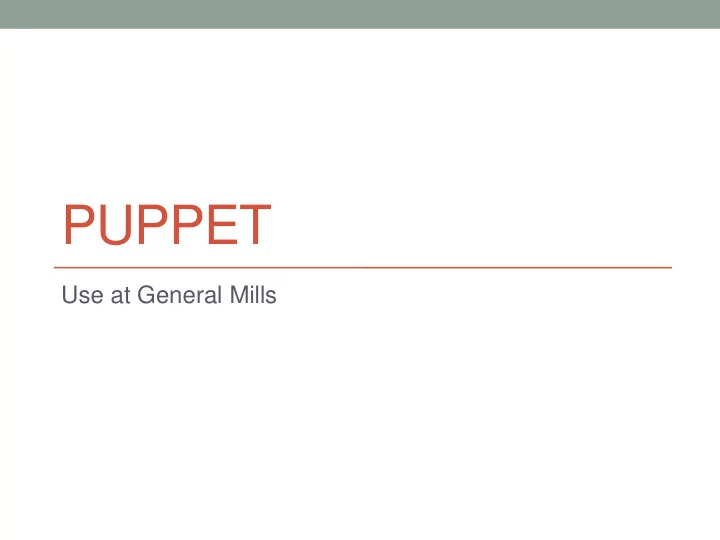

PUPPET Use at General Mills
Preface • HP UX platform at GMI is 15+ years old • Consolidated Superdome architecture today • Moving enterprise apps to RHEL6 • Oracle • SAP • BW/BI • Warehouse Management • Short migration timeframe
Preface
Topics • Puppet basics • Usage at GMI • Rough spots • Questions
What is Puppet? • Configuration management • Files • Software packages • Users/groups • Consistent interface for wide selection of OSes • Action by declaration • Multiple uses • Run-once provisioning • Continuous compliance • Audit
Components
Common Resource Types • file • nagios_* • user • ssh_authorized_key • group • tidy • mount • yumrepo • package • augeas • service • cron • exec
Language Example user { 'httpd': ensure => present, uid => 80, gid => 80, groups => ['users', 'engr'], comment => 'Apache User' } package { 'emacs': ensure => absent }
Language Example service { 'ntpd': ensure => running, enable => true } file { 'ntp.conf': path => '/etc/ntp.conf', content => template('ntp/ntp.erb'), notify => Service['ntpd'] }
Language Example class ntp { package { 'ntp' : … } file { 'ntp.conf ': … require => Package['ntp'] } service { 'ntpd' : … require => File['ntp.conf'] } }
Language Example (cont.) node 'appserver1.genmills.com' { include 'ntp' include 'kerberos' class { 'net': search => 'genmills.com' } net::iface { 'eth0': address => '3.3.3.3/24', mtu => 1500 } }
RHEL6 Install Main RPMs from PuppetLabs: http://yum.puppetlabs.com/el/6/products/x86_64/ • puppet.noarch • Agent/client • puppet-server.noarch • Master/server • facter.x86_64 • Agent data collection • Pure Ruby despite arch tag
RHEL6 Install Augeas from RHN server-optional channel: • augeas.$ARCH • Structure config file manipulations EPEL for ruby-augeas: • http://dl.fedoraproject.org/pub/epel/6/x86_64/repoview/ruby-augeas.html • ruby-augeas.noarch • Ruby bindings
Resources PuppetLabs http://docs.puppetlabs.com/puppet/ Pro Puppet ISBN - 978-1430230571
Puppet at GMI • Initial provisioning via RHN Satellite • No machine-specific configuration in Kickstart • All RHEL hosts provisioned/controlled this way • Running 2.7.x agents/masters • Headed to 3.x series • sysadmin by declaration, not action
Puppet at GMI
Rough spots • Resource sharing • Source control workflow • Node inheritance (with classes)
Resource Sharing class sap_server { package { 'compat-libstdcpp-33': ensure => present } } class oracle_server { package { 'compat-libstdcpp-33': ensure => present } }
Resource Sharing • Puppet Labs stdlib for Puppet fixes this class sap_server { ensure_resource('package', 'compat-libstdcpp-33', { ensure => present } ) } • Includes many utility functions • https://github.com/puppetlabs/puppetlabs-stdlib
Node Inheritance n ode base { … } n ode 'host.com' inherits base { … } • Good - Can be more simple than ENC or Hiera • Bad - Discouraged by Puppet Labs documentation • Ugly - Parameterized classes are problematic
Node Inheritance: Example class appservice($secure) { if ($secure) { file { '/usr /app/secure': … } } } node base_node { class { 'appservice': secure => false } }
Node Inheritance: Example node 'box.genmills.com' inherits base_node { Class['appservice'] { secure => true } } • /usr/app/secure will not be created • Class parameters aren't overridden between nodes
Node Inheritance: Hack class appservice($secure) { if ($secure) { file { '/usr /app/secure': … } } } define appservice::instance($secure) { class { 'appservice': secure => $secure } }
Node Inheritance: Hack Usage node base_node { appservice::instance { 'appservice': secure => false } } node 'box.genmills.com' inherits base_node { Appservice::Instance['appservice'] { secure => true } }
Node Inheritance: Worth it? Caveats: • Different syntax for invocation and alteration • Class variables are inaccessible to outside • Naming standards must be followed • Language changes might have negative effects
Workflow • Source control is strongly recommended • Git is a popular choice • Steeper learning curve than "traditional" VCSs • Flexible structure lends itself well to the task • Plan for change/feature promotion process • Test isolation is a must
Workflow: Using git Sandbox Dev Prod Commit 1 Commit 1 Commit 1 Commit 2 Commit 2 Commit 2 Commit 3 Commit 3 Commit 3 Commit 4 Commit 4 Commit 4
Workflow: Failure Sandbox Dev Prod Base Base Base Stable Item Stable Item Stable Item Danger Item Danger Item Danger Item Prod Fix Prod Fix Prod Fix
Workflow: Fixed Sandbox Dev Prod Base Base Base Stable Item Stable Item Danger Item Prod Fix Prod Fix Prod Fix
Workflow: How? • Manipulating (meddling) with git history • git reset – hard <commit> • Use clones, not branches, for safety • Know how far back to turn the clock • Automation in the works
Questions?
Recommend
More recommend